引言:
方法论
- 对于笔试:一切为了时间复杂度,不用在乎空间复杂度
- 对于面试:时间复杂度放在首位,空间复杂度尽量最小
重要技巧
链表回文
方式1 利用快慢指针走到中点,将链表后一半放入栈
1
2
3
4
5
6
7
8
9
10
11
12
13
14
15
16
17
18
19
20
21
22
23
24
25
26
27
28
29
30
31
32
33
34
35
36
|
public boolean isPalindrome(Node head) {
if (head == null || head.next == null) {
return true;
}
Stack<Node> stack = new Stack<Node>();
Node right = head.next;
Node cur = head;
while (cur.next != null || cur.next.next != null) {
right = right.next;
cur = cur.next.next;
}
while (right != null) {
stack.push(right);
right = right.next;
}
while (!stack.isEmpty()) {
if (head.val != stack.pop().val) {
return false;
}
head = head.next;
}
return true;
}
|
方式2 利用快慢指针走到中点,将链表后一部分反转,双指针遍历
1
2
3
4
5
6
7
8
9
10
11
12
13
14
15
16
17
18
19
20
21
22
23
24
25
26
27
28
29
30
31
32
33
34
35
36
37
38
39
40
41
42
43
44
45
46
47
48
49
50
51
52
53
54
55
56
57
58
59
60
61
62
63
64
65
66
67
68
69
70
71
72
73
74
75
76
77
78
79
80
|
public boolean isPalindrome2(Node head) {
if (head == null || head.next == null) {
return true;
}
Node slowNode = head;
Node fastNode = head;
while (fastNode.next != null && fastNode.next.next != null) {
slowNode = slowNode.next;
fastNode = fastNode.next.next;
}
fastNode = slowNode.next;
slowNode.next = null;
Node tempNode = null;
while (fastNode != null) {
tempNode = fastNode.next;
fastNode.next = slowNode;
slowNode = fastNode;
fastNode = tempNode;
}
tempNode = slowNode;
fastNode = head;
boolean res = true;
while (slowNode != null && fastNode != null) {
if (slowNode.val != fastNode.val) {
res = false;
break;
}
slowNode = slowNode.next;
fastNode = fastNode.next;
}
slowNode = tempNode.next;
tempNode.next = null;
while (slowNode != null) {
fastNode = slowNode.next;
slowNode.next = tempNode;
tempNode = slowNode;
slowNode = fastNode;
}
return res;
}
|
链表划分
问题
给定一个单链表的头节点head,节点的值类型是整型,再给定一个整数pivot。实现一个调整链表的函数,将链表调整为左部分都是值小于pivot的节点,中间部分都是值等于pivot的节点,右部分都是值大于pivot的节点。
进阶
算法图解
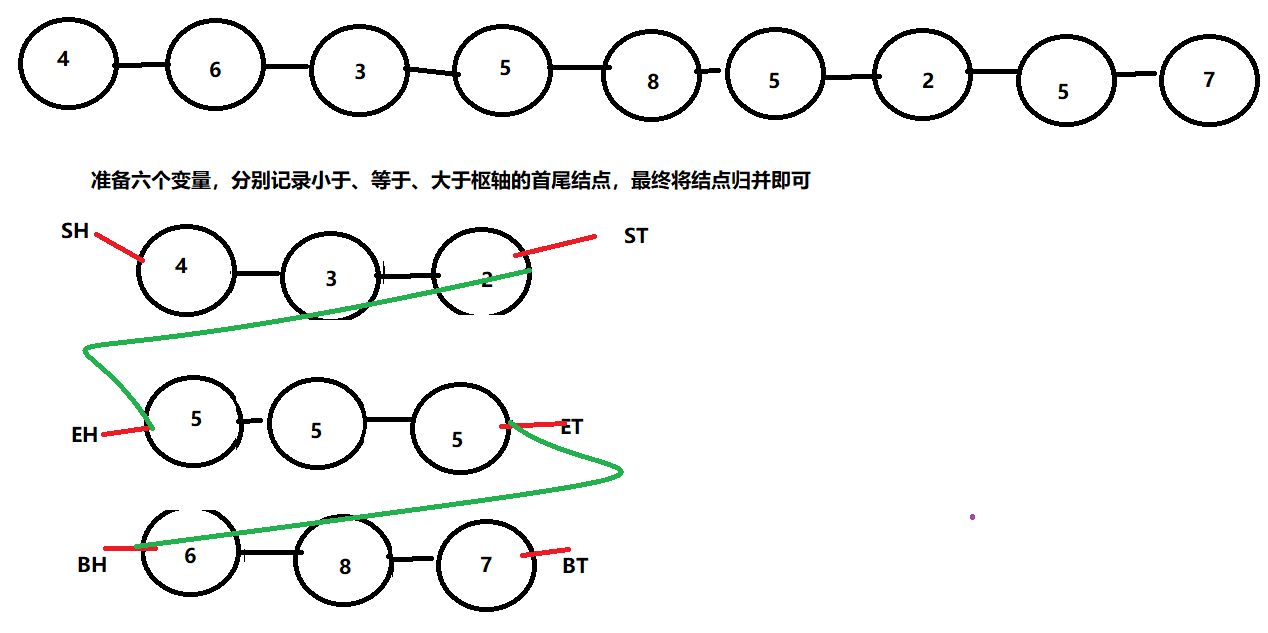
1
2
3
4
5
6
7
8
9
10
11
12
13
14
15
16
17
18
19
20
21
22
23
24
25
26
27
28
29
30
31
32
33
34
35
36
37
38
39
40
41
42
43
44
45
46
47
48
49
50
51
52
53
54
55
56
57
58
59
60
61
62
63
64
65
66
67
68
69
70
71
72
73
74
75
76
77
78
| public Node listPartition(Node head, int pivot) {
Node sH = null; Node sT = null;
Node eH = null; Node eT = null;
Node bH = null; Node bT = null;
Node next = null;
while (head != null) {
next = head.next;
head.next = null;
if (head.val < pivot) {
if (sH == null) {
sH = head;
sT = head;
} else {
sT.next = head;
sT = head;
}
} else if (head.val == pivot) {
if (eH == null) {
eH = head;
eT = head;
} else {
eT.next = head;
eT = head;
}
} else {
if (bH == null) {
bH = head;
bT = head;
} else {
bT.next = head;
bT = head;
}
}
head = next;
}
if (sT != null) {
sT.next = eH;
eT = eT == null ? sT : eT;
}
if (eT != null){
eT.next = bH;
}
return sH != null ? sH : eH != null ? eH : bH;
}
|
复制含有随机指针节点的链表
问题
定义一种特殊单链表结点类,描述如下:
1
2
3
4
5
6
7
8
| class Node {
int value;
Node next;
Node rand;
Node(int val) {
value = val;
}
}
|
rand指针是单链表结点结构中新增的指针,rand可能指向链表中的任意一个结点,也可能指向null。给定一个由Node结点类型组成的无环单链表的头结点head,请实现一个函数完成这个链表的复制,并返回复制的新链表的头结点。
[要求] 时间复杂度$O(N)$,额外空间复杂度 $O(1)$
算法思想
准备哈希表,键值对为原始节点,克隆的新节点,克隆操作是,来到原始链表节点1,拷贝next与random,直到遍历完所有原始链表
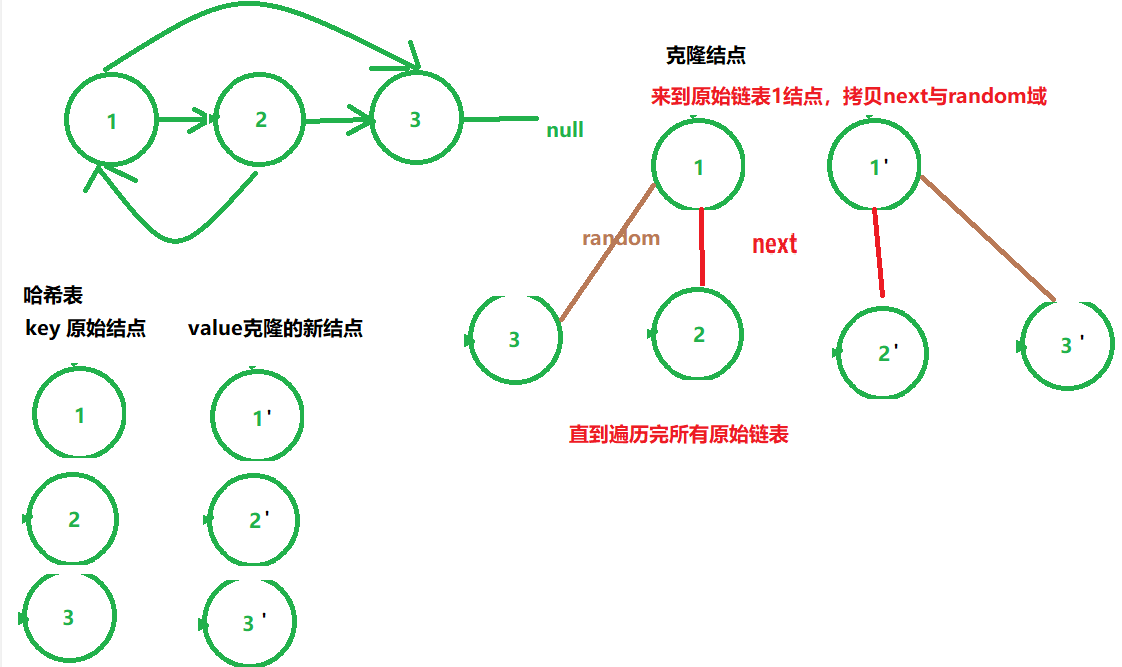
1
2
3
4
5
6
7
8
9
10
11
12
13
14
15
16
17
18
19
20
21
22
23
24
| public Node copyListWithRandom(Node head) {
HashMap<Node, Node> map = new HashMap<>();
Node cur = head;
while (cur != null) {
map.put(cur, new Node(cur.value));
cur = cur.next;
}
cur = head;
while (cur != null) {
map.get(cur).next = map.get(cur.next);
map.get(cur).rand = map.get(cur.rand);
cur = cur.next;
}
return map.get(head);
}
|
链表相交问题
问题
给定两个可能有环也可能无环的单链表,头结点head1和head2。请实现一个函数,如果两个链表相交,请返回相交的第一个结点。如果不相交,返回null。
要求
如果两个链表长度和为 $N$,时间复杂度达到 $O(N)$,额外空间复杂度达到 $O(1)$
单链表是否有环
问题
如何判断一个链表有环,如果有,返回第一个入环口,没有返回null
算法思想
设置快慢指针,快指针走两步,慢指针走一步
如果没有环快指针会先到达终点
1
2
3
4
5
6
7
8
9
10
11
12
13
14
15
16
17
18
19
20
21
22
23
24
25
26
27
28
29
30
31
32
|
public Node getLoopNode(Node head) {
if (head == null || head.next == null) {
return null;
}
Node slow = head.next;
Node fast = head.next.next;
while (fast != slow) {
if (fast.next == null || fast.next.next == null) {
return null;
}
fast = fast.next.next;
slow = slow.next;
}
fast = head;
while (fast != slow) {
fast = fast.next;
slow = slow.next;
}
return slow;
}
|
备注:如果一个链表有环,另一个链表无环,那么这个链表是无论也不可能相交的。能相交的就是两个情况:
两个链表都无环
两个链表都有环
两个无环链表相交
问题
如何判断两个无环链表是否相交,相交则返回第一个相交节点,不相交返回null
算法思想
指针1从头结点开始,走到最后一个结点(不是结束),统计链表1的长度len1,记录链表1的最后一个结点为end1
链表2从头结点开始,走到最后一个结点(不是结束),统计链表2的长度len2,记录链表2的最后给一个结点end2
如果end1!=end2,说明两个链表不相交,返回null即可;如果end1==end2,说明两个链表相交,进入下一步. 来寻找第一个相交的结点
如果链表1比较长,链表1就先走len1-len2步;如果链表2比较长,链表2就先走len2-len1步。然后两个链表一起走,两个链表第一次走到一起的结点就是第一个相交的结点
1
2
3
4
5
6
7
8
9
10
11
12
13
14
15
16
17
18
19
20
21
22
23
24
25
26
27
28
29
30
31
32
33
34
35
36
37
38
39
40
41
42
43
44
45
46
47
48
49
50
51
52
|
public Node noLoop(Node head1, Node head2) {
if (head1 == null || head2 == null) {
return null;
}
Node cur1 = head1;
Node cur2 = head2;
int len = 0;
while (cur1.next != null) {
len++;
cur1 = cur1.next;
}
while (cur2.next != null) {
len--;
cur2 = cur2.next;
}
if (cur1 != cur2) {
return null;
}
cur1 = len > 0 ? head1 : head2;
cur2 = cur1 == head1 ? head2 : head1;
len = Math.abs(len);
while (len != 0) {
len--;
cur1 = cur1.next;
}
while (cur1 != cur2) {
cur1 = cur1.next;
cur2 = cur2.next;
}
return cur1;
}
|
两个有环链表相交
问题
如何判断两个有环链表相交,相交则返回第一个相交节点,不相交返回null
[loop1 == loop2 两个链表相交图示]
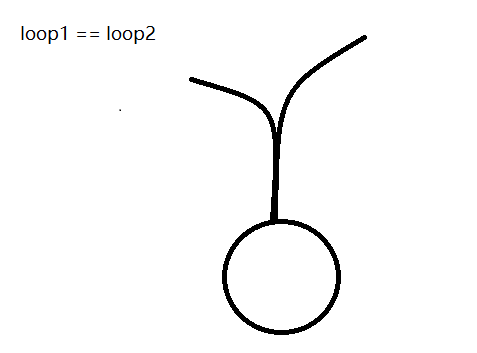
[loop1 != loop2 两个链表不相交图示]
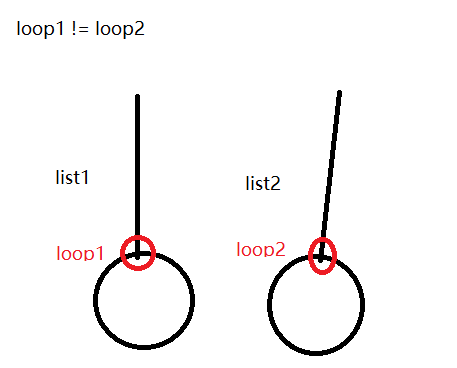
[loop1 != loop2两个链表相交图示]
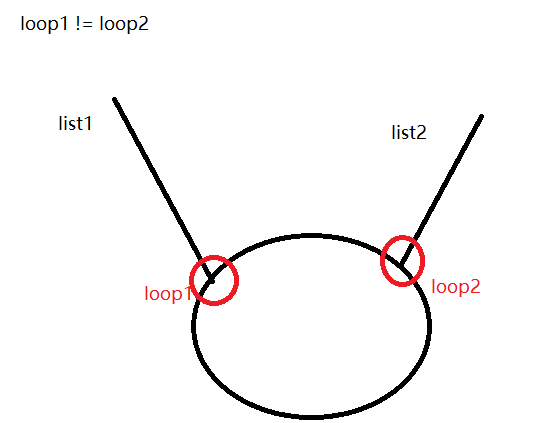
算法思想
让链表1从入环扣1(loop1)出发(由于loop1和之后的所有结点都在环上,将来一定能返回loop1)
如果回到loop1之前没有遇到loop2,说明两个链表结构如图[loop1 != loop2 两个链表不相交图示],即不相交,返回null
如果回到loop1之前遇到loop2,说明两个链表结构如图[loop1 != loop2两个链表相交图示],也就是相交
由于loop1和loop2都在两条链表上,只不过loop1是离链表1较近的结点,loop2是离链表2较近的结点,返回两者中任意一个即可
1
2
3
4
5
6
7
8
9
10
11
12
13
14
15
16
17
18
19
20
21
22
23
24
25
26
27
28
29
30
31
32
33
34
35
36
37
38
39
40
41
42
|
public Node bothLoop(Node head1, Node head2, Node loop1, Node loop2){
Node cur1 = null;
Node cur2 = null;
if (loop1 == loop2) {
cur1 = head1;
cur2 = head2;
int len = 0;
while (cur1 != loop1) {
len++;
cur1 = cur1.next;
}
while (cur2 != loop2) {
len--;
cur2 = cur1.next;
}
cur1 = len > 0 ? head1 : head2;
cur2 = cur1 == head1 ? head2 : head1;
len = Math.abs(len);
while (len != 0) {
len--;
cur1 = cur1.next;
}
while (cur1 != cur2) {
cur1 = cur1.next;
cur2 = cur2.next;
}
return cur1;
} else {
cur1 = loop1.next;
while (cur1 != loop1) {
if (cur1 == loop2) {
return loop1;
}
cur1 = cur1.next;
}
return null;
}
}
|
Total
1
2
3
4
5
6
7
8
9
10
11
12
13
14
15
16
17
18
19
20
21
22
23
24
25
26
|
public Node getIntersectNode(Node head1, Node head2) {
if (head1 == null || head2 == null) {
return null;
}
Node loop1 = getLoopNode(head1);
Node loop2 = getLoopNode(head2);
if (loop1 == null && loop2 == null) {
return noLoop(head1, head2);
}
if (loop1 != null && loop2 != null) {
return bothLoop(head1, loop1, head2, loop2);
}
return null;
}
|















